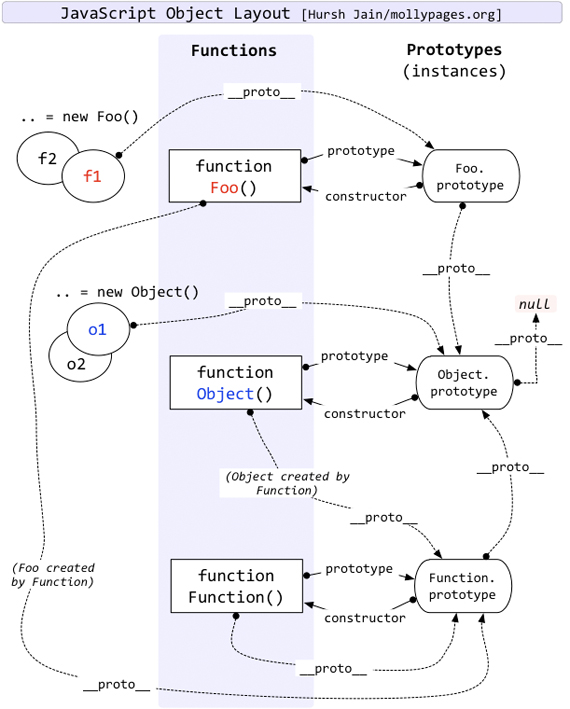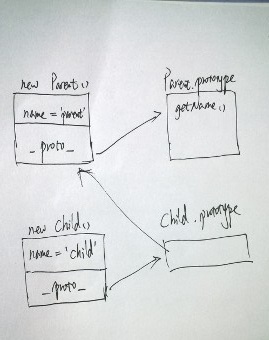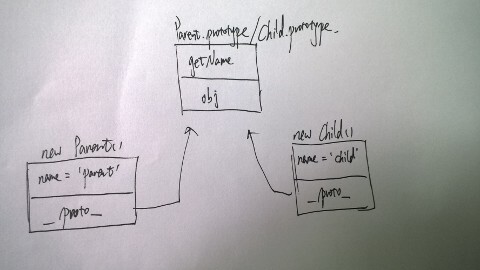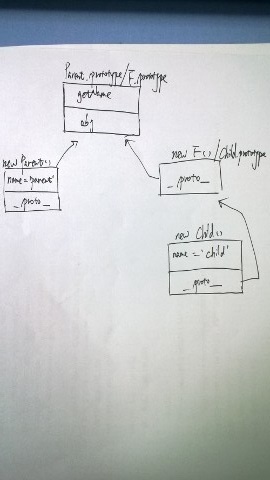再谈javascript原型继承
Javascript原型继承是一个被说烂掉了的话题,但是自己对于这个问题一直没有彻底理解,今天花了点时间又看了一遍《Javascript模式》中关于原型实现继承的几种方法,下面来一一说明下,在最后我根据自己的理解提出了一个关于继承比较完整的实现。
真正意义上来说Javascript并不是一门面向对象的语言,没有提供传统的继承方式,但是它提供了一种原型继承的方式,利用自身提供的原型属性来实现继承。
原型与原型链
说原型继承之前还是要先说说原型和原型链,毕竟这是实现原型继承的基础。
在Javascript中,每个函数都有一个原型属性prototype指向自身的原型,而由这个函数创建的对象也有一个__proto__属性指向这个原型,而函数的原型是一个对象,所以这个对象也会有一个__proto__指向自己的原型,这样逐层深入直到Object对象的原型,这样就形成了原型链。下面这张图很好的解释了Javascript中的原型和原型链的关系。

每个函数都是Function函数创建的对象,所以每个函数也有一个__proto__属性指向Function函数的原型。这里需要指出的是,真正形成原型链的是每个对象的__proto__属性,而不是函数的prototype属性,这是很重要的。
原型继承
基本模式
this.name = 'parent' ;
} ;
Parent.prototype.getName = function(){
return this.name ;
} ;
Parent.prototype.obj = {a : 1} ;
var Child = function(){
this.name = 'child' ;
} ;
Child.prototype = new Parent() ;
var parent = new Parent() ;
var child = new Child() ;
console.log(parent.getName()) ; //parent
console.log(child.getName()) ; //child
这种是最简单实现原型继承的方法,直接把父类的对象赋值给子类构造函数的原型,这样子类的对象就可以访问到父类以及父类构造函数的prototype中的属性。 这种方法的原型继承图如下:

这种方法的优点很明显,实现十分简单,不需要任何特殊的操作;同时缺点也很明显,如果子类需要做跟父类构造函数中相同的初始化动作,那么就得在子类构造函数中再重复一遍父类中的操作:
this.name = name || 'parent' ;
} ;
Parent.prototype.getName = function(){
return this.name ;
} ;
Parent.prototype.obj = {a : 1} ;
var Child = function(name){
this.name = name || 'child' ;
} ;
Child.prototype = new Parent() ;
var parent = new Parent('myParent') ;
var child = new Child('myChild') ;
console.log(parent.getName()) ; //myParent
console.log(child.getName()) ; //myChild
上面这种情况还只是需要初始化name属性,如果初始化工作不断增加,这种方式是很不方便的。因此就有了下面一种改进的方式。
借用构造函数
this.name = name || 'parent' ;
} ;
Parent.prototype.getName = function(){
return this.name ;
} ;
Parent.prototype.obj = {a : 1} ;
var Child = function(name){
Parent.apply(this,arguments) ;
} ;
Child.prototype = new Parent() ;
var parent = new Parent('myParent') ;
var child = new Child('myChild') ;
console.log(parent.getName()) ; //myParent
console.log(child.getName()) ; //myChild
上面这种方法在子类构造函数中通过apply调用父类的构造函数来进行相同的初始化工作,这样不管父类中做了多少初始化工作,子类也可以执行同样的初始化工作。但是上面这种实现还存在一个问题,父类构造函数被执行了两次,一次是在子类构造函数中,一次在赋值子类原型时,这是很多余的,所以我们还需要做一个改进:
this.name = name || 'parent' ;
} ;
Parent.prototype.getName = function(){
return this.name ;
} ;
Parent.prototype.obj = {a : 1} ;
var Child = function(name){
Parent.apply(this,arguments) ;
} ;
Child.prototype = Parent.prototype ;
var parent = new Parent('myParent') ;
var child = new Child('myChild') ;
console.log(parent.getName()) ; //myParent
console.log(child.getName()) ; //myChild
这样我们就只需要在子类构造函数中执行一次父类的构造函数,同时又可以继承父类原型中的属性,这也比较符合原型的初衷,就是把需要复用的内容放在原型中,我们也只是继承了原型中可复用的内容。上面这种方式的原型图如下:

临时构造函数模式(圣杯模式)
上面借用构造函数模式最后改进的版本还是存在问题,它把父类的原型直接赋值给子类的原型,这就会造成一个问题,就是如果对子类的原型做了修改,那么这个修改同时也会影响到父类的原型,进而影响父类对象,这个肯定不是大家所希望看到的。为了解决这个问题就有了临时构造函数模式。
this.name = name || 'parent' ;
} ;
Parent.prototype.getName = function(){
return this.name ;
} ;
Parent.prototype.obj = {a : 1} ;
var Child = function(name){
Parent.apply(this,arguments) ;
} ;
var F = new Function(){} ;
F.prototype = Parent.prototype ;
Child.prototype = new F() ;
var parent = new Parent('myParent') ;
var child = new Child('myChild') ;
console.log(parent.getName()) ; //myParent
console.log(child.getName()) ; //myChild
该方法的原型继承图如下:

很容易可以看出,通过在父类原型和子类原型之间加入一个临时的构造函数F,切断了子类原型和父类原型之间的联系,这样当子类原型做修改时就不会影响到父类原型。
我的方法
《Javascript模式》中到圣杯模式就结束了,可是不管上面哪一种方法都有一个不容易被发现的问题。大家可以看到我在'Parent'的prototype属性中加入了一个obj对象字面量属性,但是一直都没有用。我们在圣杯模式的基础上来看看下面这种情况:
this.name = name || 'parent' ;
} ;
Parent.prototype.getName = function(){
return this.name ;
} ;
Parent.prototype.obj = {a : 1} ;
var Child = function(name){
Parent.apply(this,arguments) ;
} ;
var F = new Function(){} ;
F.prototype = Parent.prototype ;
Child.prototype = new F() ;
var parent = new Parent('myParent') ;
var child = new Child('myChild') ;
console.log(child.obj.a) ; //1
console.log(parent.obj.a) ; //1
child.obj.a = 2 ;
console.log(child.obj.a) ; //2
console.log(parent.obj.a) ; //2
在上面这种情况中,当我修改child对象obj.a的时候,同时父类的原型中的obj.a也会被修改,这就发生了和共享原型同样的问题。出现这个情况是因为当访问child.obj.a的时候,我们会沿着原型链一直找到父类的prototype中,然后找到了obj属性,然后对obj.a进行修改。再看看下面这种情况:
this.name = name || 'parent' ;
} ;
Parent.prototype.getName = function(){
return this.name ;
} ;
Parent.prototype.obj = {a : 1} ;
var Child = function(name){
Parent.apply(this,arguments) ;
} ;
var F = new Function(){} ;
F.prototype = Parent.prototype ;
Child.prototype = new F() ;
var parent = new Parent('myParent') ;
var child = new Child('myChild') ;
console.log(child.obj.a) ; //1
console.log(parent.obj.a) ; //1
child.obj.a = 2 ;
console.log(child.obj.a) ; //2
console.log(parent.obj.a) ; //2
这里有一个关键的问题,当对象访问原型中的属性时,原型中的属性对于对象来说是只读的,也就是说child对象可以读取obj对象,但是无法修改原型中obj对象引用,所以当child修改obj的时候并不会对原型中的obj产生影响,它只是在自身对象添加了一个obj属性,覆盖了父类原型中的obj属性。而当child对象修改obj.a时,它先读取了原型中obj的引用,这时候child.obj和Parent.prototype.obj是指向同一个对象的,所以child对obj.a的修改会影响到Parent.prototype.obj.a的值,进而影响父类的对象。AngularJS中关于$scope嵌套的继承方式就是模范Javasript中的原型继承来实现的。
根据上面的描述,只要子类对象中访问到的原型跟父类原型是同一个对象,那么就会出现上面这种情况,所以我们可以对父类原型进行拷贝然后再赋值给子类原型,这样当子类修改原型中的属性时就只是修改父类原型的一个拷贝,并不会影响到父类原型。具体实现如下:
source = source || {} ;
var toStr = Object.prototype.toString ,
arrStr = '[object array]' ;
for(var i in source){
if(source.hasOwnProperty(i)){
var item = source[i] ;
if(typeof item === 'object'){
target[i] = (toStr.apply(item).toLowerCase() === arrStr) : [] ? {} ;
deepClone(item,target[i]) ;
}else{
deepClone(item,target[i]) ;
}
}
}
return target ;
} ;
var Parent = function(name){
this.name = name || 'parent' ;
} ;
Parent.prototype.getName = function(){
return this.name ;
} ;
Parent.prototype.obj = {a : '1'} ;
var Child = function(name){
Parent.apply(this,arguments) ;
} ;
Child.prototype = deepClone(Parent.prototype) ;
var child = new Child('child') ;
var parent = new Parent('parent') ;
console.log(child.obj.a) ; //1
console.log(parent.obj.a) ; //1
child.obj.a = '2' ;
console.log(child.obj.a) ; //2
console.log(parent.obj.a) ; //1
综合上面所有的考虑,Javascript继承的具体实现如下,这里只考虑了Child和Parent都是函数的情况下:
source = source || {} ;
var toStr = Object.prototype.toString ,
arrStr = '[object array]' ;
for(var i in source){
if(source.hasOwnProperty(i)){
var item = source[i] ;
if(typeof item === 'object'){
target[i] = (toStr.apply(item).toLowerCase() === arrStr) : [] ? {} ;
deepClone(item,target[i]) ;
}else{
deepClone(item,target[i]) ;
}
}
}
return target ;
} ;
var extend = function(Parent,Child){
Child = Child || function(){} ;
if(Parent === undefined)
return Child ;
//借用父类构造函数
Child = function(){
Parent.apply(this,argument) ;
} ;
//通过深拷贝继承父类原型
Child.prototype = deepClone(Parent.prototype) ;
//重置constructor属性
Child.prototype.constructor = Child ;
} ;
总结
说了这么多,其实Javascript中实现继承是十分灵活多样的,并没有一种最好的方法,需要根据不同的需求实现不同方式的继承,最重要的是要理解Javascript中实现继承的原理,也就是原型和原型链的问题,只要理解了这些,自己实现继承就可以游刃有余。
再谈javascript原型继承的更多相关文章
- 彻底理解Javascript原型继承
彻底理解Javascript原型继承 之前写过一篇Javascript继承主题的文章,这篇文章作为一篇读书笔记,分析的不够深入. 本文试图进一步思考,争取彻底理解Javascript继承原理 实例成员 ...
- [转]Javascript原型继承
真正意义上来说Javascript并不是一门面向对象的语言,没有提供传统的继承方式,但是它提供了一种原型继承的方式,利用自身提供的原型属性来实现继承.Javascript原型继承是一个被说烂掉了的话题 ...
- JavaScript原型继承工作原理
原型继承的定义 当你阅读关于JS原型继承的解释时,你时常会看到以下这段文字: 当查找一个对象的属性时,JavaScript 会向上遍历原型链,直到找到给定名称的属性为止.——出自JavaScript秘 ...
- 再谈JavaScript的数据类型问题
JavaScript的数据类型问题已经讨论过很多次了,但许多人还有许多书仍然沿用着错误的.混乱的一些观点,所以就再细讲一回. 提及这个讨论的原因在于argb同学在我的MSN博客上的一段回复,又更早的起 ...
- 再谈javascriptjs原型与原型链及继承相关问题
什么是原型语言 只有对象,没有类;对象继承对象,而不是类继承类. “原型对象”是核心概念.原型对象是新对象的模板,它将自身的属性共享给新对象.一个对象不但可以享有自己创建时和运行时定义的属性,而且可以 ...
- 再谈javascript面向对象编程
前言:虽有陈皓<Javascript 面向对象编程>珠玉在前,但是我还是忍不住再画蛇添足的补上一篇文章,主要是因为javascript这门语言魅力.另外这篇文章是一篇入门文章,我也是才开始 ...
- 【读书笔记】读《编写高质量代码—Web前端开发修炼之道》 - JavaScript原型继承与面向对象
JavaScript是基于原型的语言,通过new实例化出来的对象,其属性和行为来自于两部分,一部分来自于构造函数,另一部分是来自于原型.构造函数中定义的属性和行为的优先级比原型中定义的属性和优先级高, ...
- 浅析Javascript原型继承(转)
引自: http://blog.csdn.net/kittyjie/article/details/4380918 原作者解释的浅显易懂,非常不错的JavaScript prototype总结 JS没 ...
- 浅谈JavaScript中继承的实现
谈到js中的面向对象编程,都有一个共同点,选择原型属性还是构造函数,两者各有利弊,而就片面的从js的对象创建以及继承的实现两个方面来说,官方所推荐的是两个相结合,各尽其责,各取其长,在前面的例子中,我 ...
随机推荐
- js求字符长度
</script> <!DOCTYPE html> <html lang="en"> <head> <meta charset ...
- 统计机器翻译(SMT)步骤总结
本文是在Niutrans论坛中的系列教程中总结出来的. 1.语料预处理 预处理的结果是生成双语分词之后的文件,该步需要注意的是对规则短语,比如数字.日期.网址等,进行泛化处理.可以用正则方法或者其它方 ...
- app发布流程详解
https://developer.apple.com 1. 点击 Member Center 2. 创建应用ID 3. 创建项目 4. 在AppStore创建对应的应用 5. 创建授权文件 6. 配 ...
- win7设置虚拟wifi
1. cmd,使用管理员权限打开: 2. 设置:netsh wlan set hostednetwork mode=allow ssid=ABCD key=12345678 mode:是否开启虚拟wi ...
- 3.5 linux 0.11 目标文件格式
在Linux0.11系统中,GNU gcc或gas编译输出的目标模块文件和链接程序生成的可执行文件都使用了UNIX传统的a.out格式.这是一种被称为汇编与链接输出(Assembly & li ...
- 137 Single Number II(找唯一数Medium)
题目意思:一个int数组,有一个数只出现一次,其他数均出现三次,找到这个唯一数 思路: 1.将所有数用2进制表示,计算每一位的数字和 1*3*n1+0*3*n2+c 唯一数对应位的数字(0或者1 ...
- Flask学习记录之使用Werkzeug散列密码
数据库中直接存放明文密码是很危险的,Werkzeug库中的security能够方便的实现散列密码的计算 security库中 generate_password_hash(password,metho ...
- sort对二维字符数组排序(转)
由于二维字符数组的第二维没有赋值运算符,即不能对整个一维数组进行赋值,因此是无法直接对二维数组用sort进行排序的,解决办法有二种: 代码一: #include <iostream> #i ...
- Codeforces 556A Case of the Zeros and Ones(消除01)
Time Limit:1000MS Memory Limit:262144KB 64bit IO Format:%I64d & %I64u Description Andr ...
- socket本地模拟UDP 服务器+客户端(三)
UDP: TCP是建立可靠连接,并且通信双方都可以以流的形式发送数据.相对TCP,UDP则是面向无连接的协议. 使用UDP协议时,不需要建立连接,只需要知道对方的IP地址和端口号,就可以直接发数据包. ...
